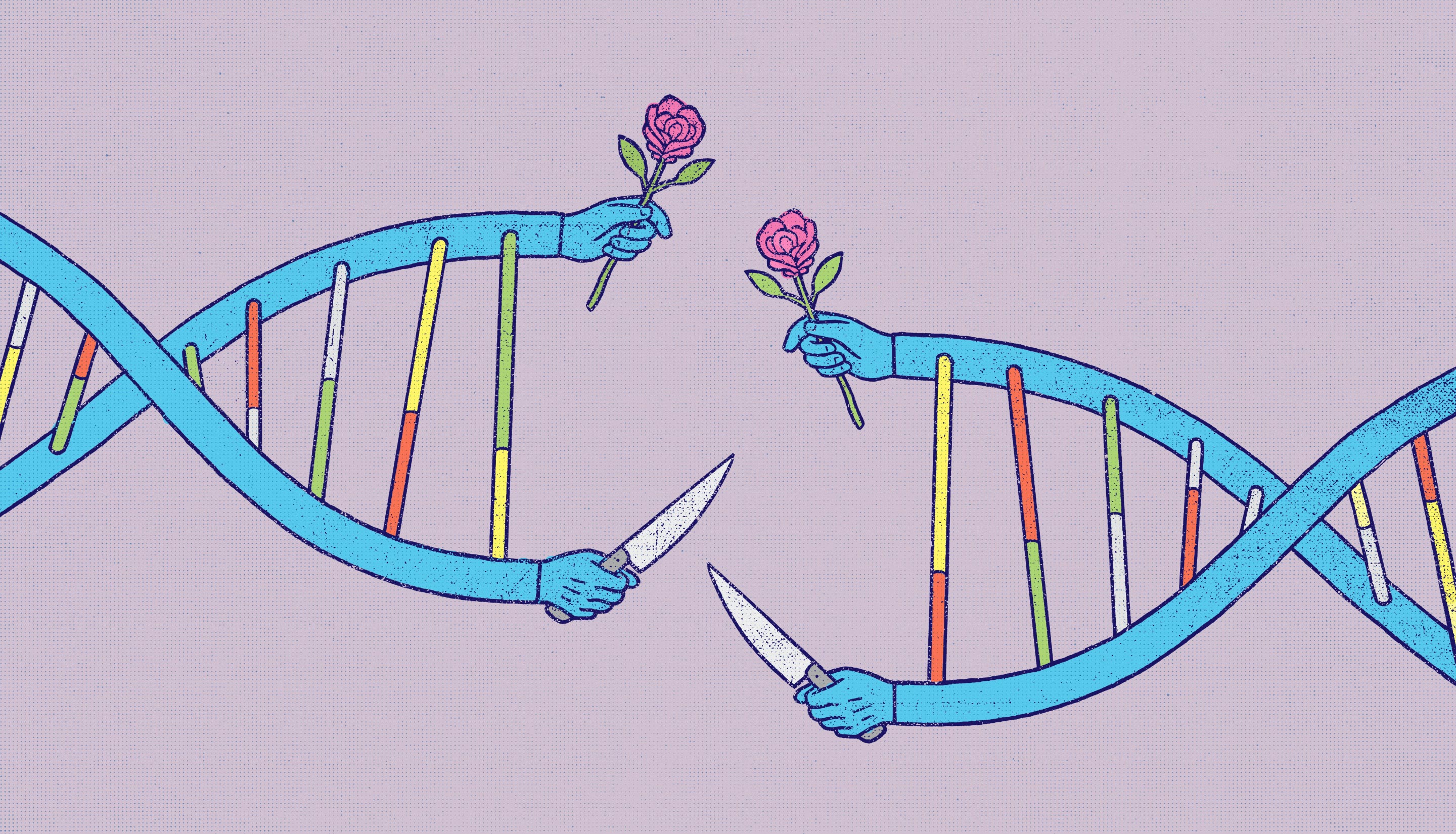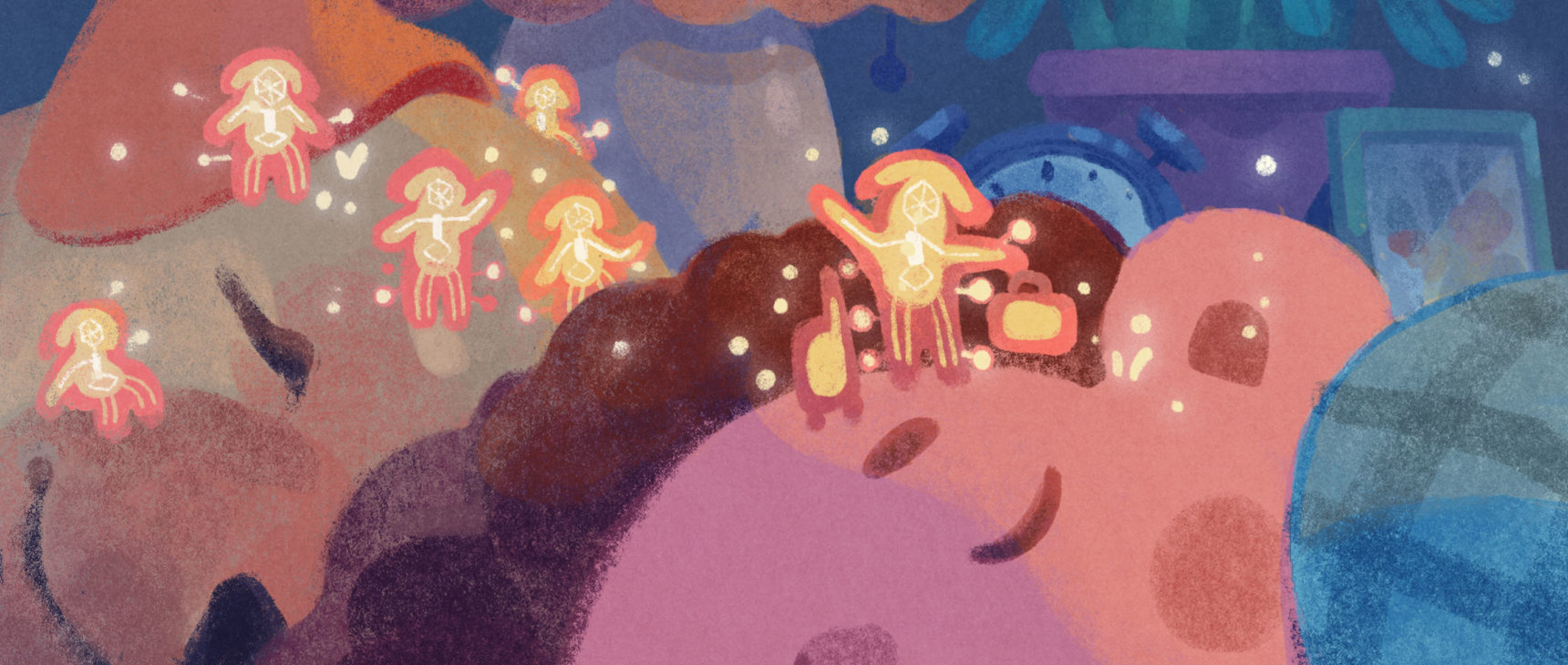Are Genes Selfish or Cooperative?

Dan Page for Quanta Magazine
Introduction
Imagine a bunch of diverse, talented individuals working on a project to create a highly sophisticated product in a burst of intense, focused, communal effort. Imagine them successfully creating an object so complicated that both the process and the end product are held up in history as a near miracle of goal-directed cooperation. What shining accolade would you bestow on the people who achieved this?
Actually, you don’t have to exercise your imagination at all. Such high-profile focused projects to create results of hitherto unimaginable complexity have taken place at least twice in American history. One was the Manhattan Project during the Second World War, in which America’s best and brightest scientists worked together to build the first atomic bomb in a feverish race against time. And two decades later, an equally focused and sophisticated example of teamwork gave us the Apollo 11 moon landing. We revere the individuals who made these cooperative successes possible, calling them heroes, icons of dedication and selflessness, and paragons of team play. Would it ever occur to you to refer to them as selfish, just because they were selected to do the jobs over their peers by virtue of their unique talent and merit? Hold that thought!
In this month’s Insights Puzzle, I invite you to discover for yourself a simple mathematical result of Mendelian genetics that pertains to how genes interact with each other. After that, we will weigh in on a famous metaphor for the “selfishness” of genes that I, and many others, believe is completely erroneous. But first, let’s go over some basics.
Genes are made of DNA segments that, in the simplest cases, code for a particular trait of an organism. Our genomes have well-defined places (“loci”) that may be occupied by one of two or more genes (“alleles”) that metaphorically vie for the same spot, like two players who compete to fill the same slot such as pitcher or quarterback on a championship baseball or football team. Each allele brings its individual touch to the role. In Mendel’s famous experiments on pea plants, one allele, let us say A, tended to make the plants tall, while the other, a, tended to make them short. Since most organisms have two inherited sets of genes, one contributed by each parent, an individual plant might have AA or Aa or aa to make up what’s called its genotype. Now one of the alleles (A) might be dominant over the other, so that both the AA and Aa genotype plants would be tall while aa plants would be short. When two individuals mate with or are crossed with each other to produce the next generation, one of each of their pair of genes is chosen at random to contribute to any particular offspring. Thus, if two Aa individuals mate, they can each contribute an A to produce an AA individual one-quarter of the time, or one can contribute an A and the other an a to produce an Aa individual one-half of the time, or they can both contribute an a to produce an aa individual one-quarter of the time. Our problems examine what happens in subsequent generations, given an initial mix of individuals in a given proportion.
Problem 1
Imagine a population of individuals with genotypes AA, Aa and aa in the proportions 0.5, 0.2 and 0.3, respectively. Imagine that there are very many individuals who mate with each other at random, so that every possible mating between genotypes takes place with the appropriate frequencies. Thus two AAs will mate with each other with a frequency 0.5 times 0.5 to produce 0.25 of the next generation — all of whom will also be AAs. What will the proportion of the three genotypes in the first generation be? In the second generation?
Figure out the proportion of individual genotypes in the first and second generations, as before assuming random mating in a large population, when the initial proportions of AA, Aa and aa are as follows:
- 0.3, 0.6, 0.1
- 0.2, 0.8, 0
- 0.7, 0.2, 0.1
- Any arbitrary proportion you can think of (the three numbers must add up to exactly 1)
Problem 2
In the above examples, notice what happens to the ratios in the first and second generations. Can you figure out why this happens? How do the final ratios depend on the original ratios?
If you can figure out these rules, you will have rediscovered a fundamental law of population genetics.
Problem 3
Our third problem is conceptual and hearkens back to the scenario I sketched out in the introduction. You have no doubt heard of the term “the selfish gene” based on Richard Dawkins’ 1976 bestseller of the same name, in which he stridently advanced the notion — now mainstream — that digital information in the gene is effectively immortal and must be the primary unit of selection. I agree with the many eminent scientists who have praised Dawkins’ characterization as brilliant, and I believe it fully deserves the scientific success it has achieved. I’m also an admirer of Dawkins’ writing on evolution. I would go so far as to say that if you haven’t read at least one of Dawkins’ books (my favorites are The Blind Watchmaker and River Out of Eden), you are in critical danger of being scientifically illiterate in this particular domain.
My beef is not with Dawkins’ analysis of the gene’s importance as the unit of selection, but with his metaphor of the selfish gene. Let’s examine this unfortunate metaphor in detail.
Genes are insentient things and cannot be said to have any kind of purposeful selfish or unselfish behavior. If we must apply a metaphorical property to them, we must imagine what we would call the kind of behavior they exhibit if it were demonstrated by human beings. We must restrict ourselves to behavior and interactions at the level of the genes themselves. As an example, I have already given the analogy of the Manhattan Project above. Twenty to thirty thousand genes work together in the most sophisticated ways to produce some of the most complex machinery in the universe — a living organism. What genes do is a monument to cooperation that is unequalled by any human example of team play. Yes, it is true that alleles do vie for a limited number of spots just as multiple players vie for limited places in a team. But unlike in teams selected by humans, evolution is ruthlessly, incorruptibly meritocratic: Previous performance is the only criterion for selection. There is no scope for selfishness or for sabotaging a fellow competitor à la Tonya Harding. In human teams, the players who sit out because they fall short still root for the same team, no matter how they feel about being excluded. One can imagine alleles that sit out, if they had feelings, doing the same with even more intensity: After all, their organism is the only team that they can ever be on. If it dies, so do they.
The few examples of gene behavior that can appear selfish — disruptive transposons, the male spider that gets eaten up after mating — are not commonplace in the biological world, and even here, I do not think the behavior can be characterized as selfish, for the simple reason that in evolution, the proof is always in the pudding — the long-term survival of the species.
To his credit, Dawkins did acknowledge in later editions of his book that “without departing from fundamental laws of the selfish gene theory … cooperation and mutual assistance can flourish” and that he could have called his book The Cooperative Gene. Indeed, a couple of books were subsequently published on this subject, one of them by Mark Ridley. But by this time, the damage wrought by the phrase “the selfish gene” had already taken root.
In order to reverse this damage, I believe the idea of selfish genes must be expunged completely, and the true metaphorical narrative needs to be promoted. Genes are not selfish; they are probably the most cooperative insentient objects you can imagine, engaging in unimaginably complex cooperative projects. Yes, alleles are competitive, but they are chosen strictly on evolutionary merit, and do not conflict directly with each other. Non-alleles are consummate team players. Their existence depends on creating win-win scenarios with other genes.
Furthermore, what genes do in their interactions with each other, whether competitive or cooperative, has nothing to do with whether the organisms they create are selfish or altruistic: That is a much more complex issue and depends, in higher animals, not just on the simplistic short-term calculation of situational advantages, but on the ensemble of our psychological reactions that have evolved to respond to many diverse situations. This has been pointed out by the primatologist and ethologist Frans de Waal in his book The Bonobo and the Atheist, which to my mind takes the most nuanced view on this issue. Remember, it is our genes and evolution that give us not only our selfish impulses, but also our higher ethical and moral impulses, as well as the altruistic feelings we prize, including love for our children, family and friends and the heady feeling of romantic love.
So this is our qualitative Problem 3: Can a gene act in a metaphorically selfish way and unfairly undercut one of its competitive alleles? Do readers think the behavior of any genes can be characterized as selfish? I’d love to hear your insights.
Editor’s note: The reader who submits the most interesting, creative or insightful solution (as judged by the columnist) in the comments section will receive a Quanta Magazine T-shirt. And if you’d like to suggest a favorite puzzle for a future Insights column, submit it as a comment below, clearly marked “NEW PUZZLE SUGGESTION.” (It will not appear online, so solutions to the puzzle above should be submitted separately.)
Note that we may hold comments for the first day or two to allow for independent contributions by readers.
Update: The solution has been published here.



